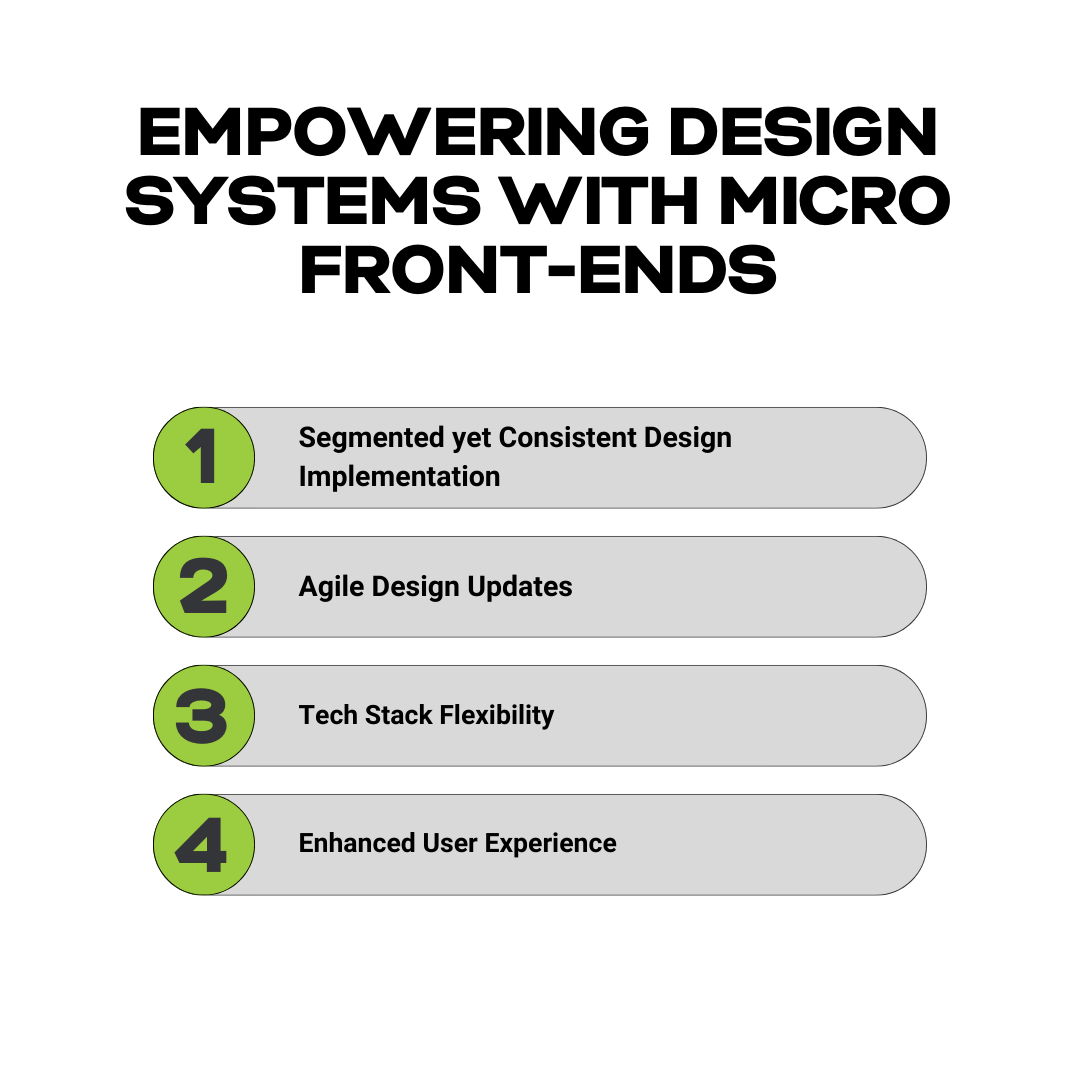In web development, staying ahead of the curve means embracing agile web design techniques and innovative approaches that not only meet current user needs but also anticipate future technological advancements.
Micro front-end design systems are revolutionizing this space, particularly in ensuring UI consistency across large-scale web applications.
Let’s delve into how this approach is redefining the effectiveness and efficiency of apps.
The Rise of Micro Front-Ends
Marking a significant paradigm shift in modular web development, micro front-ends dismantle traditional monolithic web apps into smaller, more manageable segments.
This scalable front-end architecture empowers teams to develop, test, and deploy distinct parts of an application independently. The standout feature of micro front-ends lies in their harmonious integration with design systems, significantly enhancing web application UI consistency and user experience.
Design Systems: The Blueprint for Consistency
Think of a design system as the architectural blueprint for your application’s user interface. It’s far more than just a style guide or a set of UI components; it’s a comprehensive framework that dictates how your application looks, feels, and operates. This system encompasses design principles, reusable UI components, style guidelines, and even coding best practices. It’s the DNA of your app’s design, ensuring visual and functional harmony no matter where in the application a user might navigate.
The goal of a design system is multifaceted. Primarily, it’s there to enforce consistency across the entire digital landscape of your organization. Consistency in this context means more than just using the same color palette or font family. It’s about creating a unified user experience (UX) and user interface (UI) that aligns with your brand identity and user expectations across all platforms and devices. Consistency reduces cognitive load for users, making your application more intuitive and easier to navigate.
However, implementing a design system across a large, complex application can be challenging, especially when different teams are working on different parts of the application. This is where micro front-ends come into play.
Empowering Design Systems with Micro Front-Ends
How can micro front-ends enhance the application of design systems?
- Segmented yet Consistent Design Implementation: Micro front-ends allow different teams to work on various parts of the application while adhering to the same design system. This segmentation enables faster development cycles without compromising on the uniformity and integrity of the design.
- Agile Design Updates: Updating a design system becomes less cumbersome with micro front-ends. Changes can be rolled out in phases, reducing the risk and complexity associated with large-scale updates in a monolithic architecture.
- Tech Stack Flexibility: Their beauty lies in their ability to blend with various tech stacks. This flexibility means that design systems can be implemented more efficiently, irrespective of the underlying technology.
Enhanced User Experience: With micro front-ends, the focus is on loading only what’s necessary for the user, leading to faster, more responsive applications. This directly translates to a better user experience, in line with the core principles of most design systems.

Challenges and Considerations
Integrating micro front-ends with design systems, while beneficial, does present certain challenges that teams must navigate carefully.
- Ensuring Consistent Communication: Perhaps the most significant challenge lies in maintaining consistent communication across various teams. Each team might be working on different aspects of the application, often using diverse technologies. This diversity, while a strength, can lead to discrepancies in understanding and implementing the design system. Regular and clear communication, therefore, becomes crucial. Teams must align frequently to ensure that every micro front-end component adheres to the overarching design principles and guidelines, maintaining a cohesive user experience.
- Managing Performance Overhead: Another critical consideration is the performance impact of dynamically loading different components. Micro front-ends typically rely on loading components as and when needed, which can introduce performance overheads, especially if not optimized properly. This requires a careful balance. Developers must ensure that the application remains fast and responsive, while still benefiting from their modular nature. Techniques like lazy loading, effective use of caches, and optimizing bundle sizes become key strategies in managing this overhead.
The Future is Modular
Looking ahead, the integration of micro front-ends with design systems represents an exciting frontier in web development.
- Setting New Standards: This approach is set to redefine how we think about building and maintaining web applications. By breaking down monolithic structures into more manageable, modular components that adhere to a unified design system, we’re paving the way for applications that are not just functionally sound, but also consistently deliver an intuitive and engaging user experience.
- Embracing Flexibility and User-Centric Design: The future of web development with micro front-ends and design systems is one that embraces flexibility, agility, and user-centric design. This approach allows for rapid adaptation to user feedback and market changes, ensuring that applications can evolve quickly and efficiently.
- Building Robust and Consistent Experiences: The modular nature of this approach doesn’t mean a compromise on consistency. On the contrary, it fosters an environment where consistency in design and functionality is paramount, regardless of the scale or complexity of the application.
Conclusion
Micro front-end integration with design systems represents a significant leap forward in web development. It offers a solution that balances modularity with consistency, driving efficiency and enhancing user experiences. As technology evolves, this approach will undoubtedly play a pivotal role in shaping the future of web apps.
Interested in exploring how micro front-ends can transform your web development strategy? Reach out to Aleron IT, where we create intuitive, user-friendly web apps with stellar front-end solutions for our clients!
If you would like to be informed about our opportunities in time, follow us on LinkedIn!
